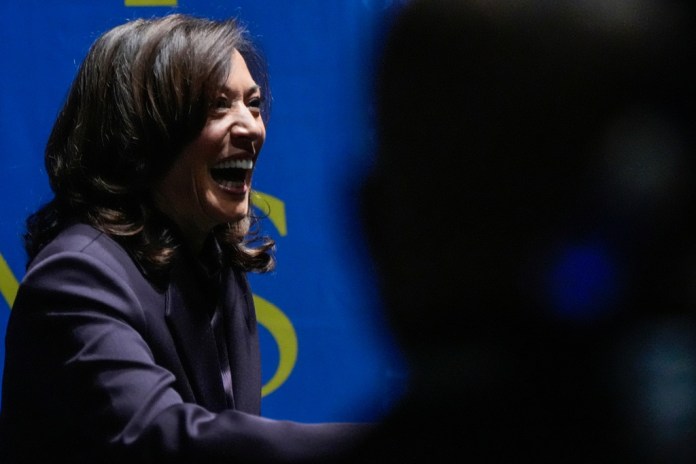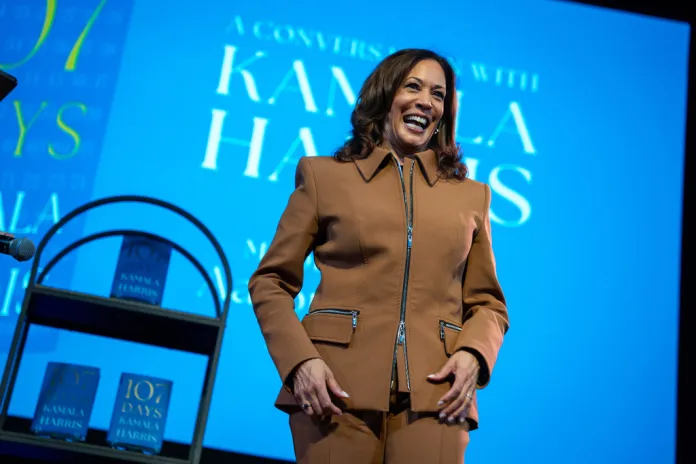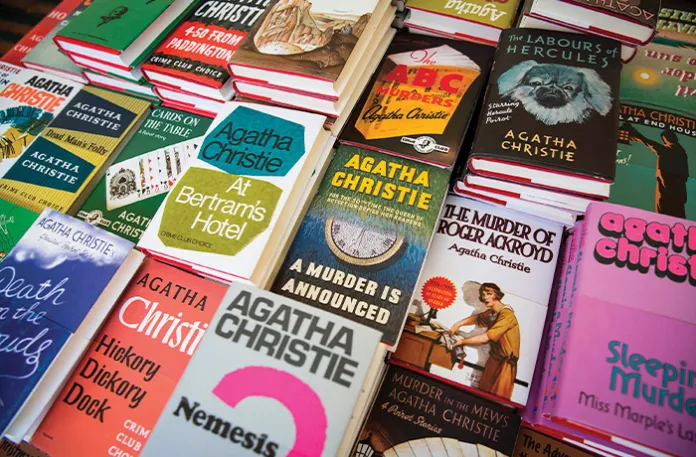Fact checking the Kamala Harris claims that ABC wouldn’t – Washington Examiner
The article discusses multiple claims made by Vice President Kamala Harris during a debate with former President Donald Trump, labeling several of them as misleading or false. Below are the key points of Harris’s claims along with the critiques provided:
1. **Unemployment Rates**:
– **Claim**: Harris stated that “Donald Trump left us the worst unemployment since the Great Depression.”
– **Critique**: The unemployment rate was at 6.3% when Biden and Harris took office, significantly impacted by pandemic-related job losses. In fact, before the pandemic, under Trump, the unemployment rate had fallen to 3.5%.
2. **Project 2025**:
– **Claim**: Harris insinuated that Trump has a “detailed and dangerous plan called Project 2025” that he intends to implement if re-elected.
- **Critique**: Trump has disavowed Project 2025, which was developed by the Heritage Foundation, and his campaign played no role in its creation.
3. **Abortion Claims**:
– **Claim**: “Nowhere in America is a woman carrying a pregnancy to term and asking for an abortion.”
- **Critique**: This statement ignores that in several states, laws allow women to seek abortions late in pregnancy, and some abortions do occur in the later stages.
4. **Trump’s “Bloodbath” Comment**:
– **Claim**: Harris suggested that Trump threatened a “bloodbath” if he loses the election.
– **Critique**: The comment was taken out of context; Trump was referring to economic consequences rather than a literal threat of violence.
5. **IVF Treatments**:
– **Claim**: Harris claimed that couples are being denied in vitro fertilization (IVF) treatments due to Trump’s abortion policies.
– **Critique**: There is no direct link between abortion restrictions and IVF accessibility, which remains legal across the U.S.
6. **Charlottesville Remarks**:
– **Claim**: Harris referenced Trump’s comments regarding the 2017 Charlottesville rally, implying he equated “very fine people on both sides.”
– **Critique**: Trump’s comments have been debated; he did condemn neo-Nazis and white nationalists, trying to differentiate between various protestors.
The article emphasizes the importance of context and accuracy in political debates, highlighting how statements can be misrepresented or oversimplified in the heat of discussion.
Fact checking the Kamala Harris claims that ABC wouldn’t
Vice President Kamala Harris made a number of misleading or false claims during the debate on Tuesday, but the ABC News moderators declined to fact check her statements in real time.
David Muir and Linsey Davis faced criticism for pressing former President Donald Trump on incorrect statements while permitting his opponent to make several of her own during the two-hour debate they moderated in Philadelphia.
Here are some of the inaccurate things Harris said during her first debate with Trump.
1. “Donald Trump left us the worst unemployment since the Great Depression.”
This is a misleading statement because it omits key context that renders Harris’s underlying point meaningless.
Unemployment sat at 6.3% when President Joe Biden and Harris took office in January 2021, less than a year after the onset of the pandemic. Government mandates had forced businesses around the country to close for extended periods of time, causing the economy to shed jobs temporarily.
But once life started to return to normal, those jobs returned as well. That was already starting to happen by the time Biden was inaugurated. The unemployment rate hit double digits in the spring of 2020 and was falling significantly heading into 2021.
The unemployment rate at the end of Trump’s term, therefore, had little to do with Trump’s agenda. In fact, in the three years he was in office before the pandemic, Trump managed to bring the employment rate down to 3.5%, which was lower than the current rate under Biden and Harris.
2. “What you’re going to hear tonight is a detailed and dangerous plan called Project 2025 that the former president intends on implementing if he were elected again.”
Democrats have focused intensely on a policy document produced by the Heritage Foundation in 2023 that contains a blueprint for a future conservative administration.
Trump has repeatedly disavowed the project, and his allies have criticized the people who wrote it. While some former Trump administration officials were involved in crafting the policy blueprint, Trump’s campaign played no role in it.
Harris falsely claimed that Trump plans to follow Project 2025’s lead if elected. He has never said this, and in fact, he has repeatedly said the opposite.
3. “Nowhere in America is a woman carrying a pregnancy to term and asking for an abortion.”
When Harris and Trump sparred over abortion on the debate stage, the ABC News moderators jumped in to correct a statement Trump made about partial-birth abortion, but left unchallenged a statement from Harris about late-term abortion.
Women can seek an abortion at any point in their pregnancies, theoretically even late into their third trimester, in at least seven states and the District of Columbia, according to the Kaiser Family Foundation. Some other states allow such broad exceptions to their gestational limits on the procedure that anti-abortion advocates say women can effectively obtain an abortion at any stage.
Most abortions occur before 13 weeks of pregnancy, according to the Pew Research Center. However, Democrats have resisted placing limits on abortions occurring later than that, and a small percentage of abortions do occur later in pregnancy.
More than 900,000 abortions are performed each year in the United States, and 1% of those occur after 21 weeks, meaning thousands of abortions are performed later in pregnancy annually.
A baby is considered full-term at 37 weeks of pregnancy, and presumably, even fewer abortions are performed at that stage. However, it is not true that “nowhere in America” could a woman request an abortion late in her pregnancy. A woman in any of the states that place no gestational limits on the procedure, including Minnesota and Colorado, would legally be able to seek an abortion in the final month of her pregnancy.
The Roe v. Wade standard that Harris said she supports would allow restrictions on the procedure after roughly 24 weeks of pregnancy, or the point at which a baby has a reasonable chance of surviving outside the womb. Even that position obscures what many Democrats support, however.
While abortion restrictions based on fetal viability were permitted under the Roe framework, those restrictions were not required. Some states allowed abortion after that point, even before the Supreme Court changed how abortion law is enacted, and many Democrats have declined to say whether they support limiting the procedure at any point in pregnancy.
4. “Donald Trump the candidate has said in this election there will be a bloodbath, if … the outcome of this election is not to his liking.”
Harris repeated a talking point about comments Trump made in March that completely misrepresented what the former president actually said.
Trump never threatened a “bloodbath” in the literal sense if he loses the election in November.
Harris was referring to a quote from a Trump speech at a campaign rally in Ohio earlier this year in which the former president criticized the Biden administration’s manufacturing agenda.
“We’re going to put a 100% tariff on every single car that comes across the line, and you’re not going to be able to sell those guys if I get elected,” Trump said. “Now, if I don’t get elected, it’s going to be a bloodbath for the whole — that’s gonna be the least of it. It’s going to be a bloodbath for the country. That’ll be the least of it. But they’re not going to sell those cars. They’re building massive factories.”
Trump was clearly making an economic argument when he used the term “bloodbath” during that speech in March. However, Democrats and the media quickly spun the comment into a controversy at the time about Trump’s intentions in the event of a loss.
5. “And understand what has been happening under Donald Trump’s abortion bans. Couples who pray and dream of having a family are being denied IVF treatments.”
Setting aside the fact that Trump has not proposed an abortion ban and has not been in office since the Supreme Court cleared the way for red states to start banning abortion, Harris’s claim about IVF denials was also misleading.
There is no clear connection between the Republican-led push to restrict abortion in some states and access to fertility treatments such as IVF.
IVF is legal in all 50 states. Trump has not only advocated for protecting IVF access – he has also proposed forcing private insurance companies to cover IVF treatments.
The political debate over IVF began in February when an Alabama court ruled in favor of couples who sued a fertility clinic that accidentally destroyed their frozen embryos. The court ruled that the embryos could be considered “extrauterine children” for the purpose of filing lawsuits under wrongful death statutes.
The ruling itself did not ban IVF, but some experts acknowledged that it could make access to the treatments more difficult by increasing liability for IVF providers. Still, even the ultra-conservative Alabama legislature saw the political risks of the ruling and moved quickly to pass bills providing immunity to IVF clinics.
6. “Let’s remember Charlottesville, where there was a mob of people carrying tiki torches, spewing antisemitic hate, and what did the president then at the time say? There were fine people on each side.”
Trump’s comments in 2017 after violence broke out at a rally in Charlottesville, Virginia, have been a fixation of Democrats for years — despite fact-checkers finding that the former president did not praise white supremacists as “very fine people.”
The infamous line from Trump came in a press conference days after a protest in Charlottesville over the removal of Confederate statues from city property turned violent in August 2017. Some of the protesters chanted antisemitic sentiments and carried Nazi symbols, and the rally attracted counterprotesters from the Left who clashed with the protesters from the Right.
In the ensuing violence, a counterprotester named Heather Heyer was killed when a man rammed his car into the crowd in what the Trump administration described as an act of domestic terrorism.
During his press conference after the incident, Trump condemned the attack on the counterprotesters, saying, “I think the driver of the car is a disgrace to himself, his family, and this country.”
Trump also went after the alt-right protesters he has been accused of praising as “very fine people.”
“And you had people — and I’m not talking about the neo-Nazis and the white nationalists — because they should be condemned totally. But you had many people in that group other than neo-Nazis and white nationalists,” Trump said.
CLICK HERE TO READ MORE FROM THE WASHINGON EXAMINER
He sought to distinguish between the people carrying tiki torches and saying antisemitic things – the ones Harris mentioned during the debate on Tuesday — and the people who were on the scene solely to protest the removal of the Confederate statues.
Sparring with a reporter who said, “neo-Nazis started this,” Trump responded with the controversial line:
“Excuse me, excuse me. They didn’t put themselves — and you had some very bad people in that group, but you also had people that were very fine people, on both sides. You had people in that group. Excuse me, excuse me. I saw the same pictures as you did. You had people in that group that were there to protest the taking down of, to them, a very, very important statue and the renaming of a park from Robert E. Lee to another name.”
–Donald Trump
Trump then went on to specify that he did not mean to include the neo-Nazis in his defense of the monument protesters. Earlier this year, fact-checking organization Snopes debunked the claim that Trump praised the white supremacists at the Charlottesville rally as “very fine people.”
" Conservative News Daily does not always share or support the views and opinions expressed here; they are just those of the writer."




